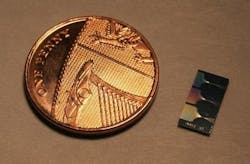Coupled waveguides on chip enable new approach to quantum computing
Bristol, England--An international research group led by scientists from the University of Bristol has developed a new approach to quantum computing based on two photons that take a quantum walk on an integrated-optical chip.1
The researchers believe that their device represents a new route to a quantum computer, a type of computer that uses quantum bits (qubits) rather than conventional bits. Unlike conventional bits, which can be in one of only two states at any one time (1 or 0), a qubit can be in several states at the same time and can therefore be used to hold and process a much larger amount of information at a greater rate.
"It is widely believed that a quantum computer will not become a reality for at least another 25 years," says Jeremy O'Brien, director of the Centre for Quantum Photonics. "However, we believe, using our new technique, a quantum computer could, in less than ten years, be performing calculations that are outside the capabilities of conventional computers."
"Walking" between 21 coupled waveguides
The technique uses two identical photons moving within an array of 21 continuously evanescently coupled waveguides on an integrated-optical chip to perform an experiment known as a quantum walk. Quantum-walk experiments using one photon have been done before, and can even be modeled exactly by classical wave physics. However, this is the first time a quantum walk has been performed with two particles -- and the implications are far-reaching.
"Using a two-photon system, we can perform calculations that are exponentially more complex than before," says O'Brien.
Useful as simulation tools
The team expects to apply the new results immediately for developing new simulation tools in their own lab. In the longer term, a quantum computer based on a multi-photon quantum walk could be used to simulate processes which themselves are governed by quantum mechanics, such as superconductivity and photosynthesis. Other applications include the development of ultrafast and efficient search engines and designing new materials and pharmaceuticals.
"Now that we can directly realize and observe two-photon quantum walks, the move to a three-photon, or multi-photon, device is relatively straightforward, but the results will be just as exciting," says O'Brien. "Each time we add a photon, the complexity of the problem we are able to solve increases exponentially, so if a one-photon quantum walk has 10 outcomes, a two-photon system can give 100 outcomes and a three-photon system 1000 solutions and so on."
The group, which includes researchers from Tohoku University, Japan, the Weizmann Institute in Israel, and the University of Twente in the Netherlands, now plans to use the chip to perform quantum-mechanical simulations. The researchers are also planning to increase the complexity of their experiment not only by adding more photons but also by using larger circuits.
REFERENCE:
1. Alberto Peruzzo et al., Science, Vol. 329. no. 5998, p. 1500, 17 September 2010.
About the Author
John Wallace
Senior Technical Editor (1998-2022)
John Wallace was with Laser Focus World for nearly 25 years, retiring in late June 2022. He obtained a bachelor's degree in mechanical engineering and physics at Rutgers University and a master's in optical engineering at the University of Rochester. Before becoming an editor, John worked as an engineer at RCA, Exxon, Eastman Kodak, and GCA Corporation.

